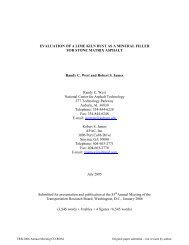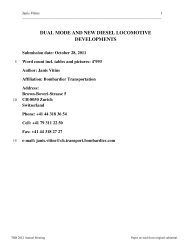influence of filler fractional voids on mastic and mixture performance
influence of filler fractional voids on mastic and mixture performance
influence of filler fractional voids on mastic and mixture performance
Create successful ePaper yourself
Turn your PDF publications into a flip-book with our unique Google optimized e-Paper software.
PROPOSED LIMITES ON FILLER RIGDEN VOIDS FOR WORKABILITY AND<br />
RUTTING RESISTANCE<br />
To incorporate the <str<strong>on</strong>g>fracti<strong>on</strong>al</str<strong>on</strong>g> <str<strong>on</strong>g>voids</str<strong>on</strong>g> into design <str<strong>on</strong>g>of</str<strong>on</strong>g> HMA, <strong>mastic</strong>s were used as the bridge between<br />
<str<strong>on</strong>g>filler</str<strong>on</strong>g> <strong>and</strong> <strong>mixture</strong> properties. Limits <str<strong>on</strong>g>of</str<strong>on</strong>g> <strong>mastic</strong> properties that result in acceptable <strong>mixture</strong><br />
<strong>performance</strong> are presented in this secti<strong>on</strong>. To relate the <strong>mastic</strong> limits to <str<strong>on</strong>g>filler</str<strong>on</strong>g> characteristics, the<br />
regressi<strong>on</strong> equati<strong>on</strong>s relating Rigden Voids <strong>and</strong> <strong>mastic</strong> properties previously presented are used.<br />
Thus, in design, <strong>on</strong>e has two opti<strong>on</strong>s:<br />
• C<strong>on</strong>duct <strong>mastic</strong> testing to quantify the <strong>mastic</strong> property value <strong>and</strong> compare to<br />
acceptable limit directly, or<br />
• Perform binder <strong>and</strong> <str<strong>on</strong>g>filler</str<strong>on</strong>g> tests <strong>and</strong> use the regressi<strong>on</strong> equati<strong>on</strong> to estimate <strong>mastic</strong><br />
property value <strong>and</strong> compare to acceptable limit.<br />
In limit development analysis, it was necessary to sort limits by gradati<strong>on</strong>. For the<br />
purpose <str<strong>on</strong>g>of</str<strong>on</strong>g> this study, a coarse aggregate gradati<strong>on</strong> is defined according to the Asphalt Institute’s<br />
definiti<strong>on</strong>. Any aggregate gradati<strong>on</strong> that crosses below 0.45 power maximum density line at or<br />
before sieve #8 (2.36mm). The fine gradati<strong>on</strong> is that which passes above the sieve #8.<br />
C<strong>on</strong>structability<br />
An extensive literature search was c<strong>on</strong>ducted to determine what limits can be used to define<br />
satisfactory workability limits <str<strong>on</strong>g>of</str<strong>on</strong>g> <strong>mixture</strong>. No such limits for the number <str<strong>on</strong>g>of</str<strong>on</strong>g> gyrati<strong>on</strong>s to<br />
92%Gmm could be found. The most comprehensive comparis<strong>on</strong> between laboratory measured<br />
<strong>and</strong> field measured compactability found was a study by Leiva <strong>and</strong> West (26). Leiva <strong>and</strong> West<br />
evaluated the ability <str<strong>on</strong>g>of</str<strong>on</strong>g> multiple laboratory measured compactability indicators to predict actual<br />
<strong>mixture</strong> compactability in the field. The authors did not recommend limits <strong>on</strong> number <str<strong>on</strong>g>of</str<strong>on</strong>g><br />
gyrati<strong>on</strong>s to reach 92%Gmm. They developed a multiple linear regressi<strong>on</strong> model to incorporate<br />
the multiple factors found to affect <strong>mixture</strong> compactability.<br />
Since no limits for number <str<strong>on</strong>g>of</str<strong>on</strong>g> gyrati<strong>on</strong>s to reach 92%Gmm exist in the literature, limits<br />
are based <strong>on</strong> the results <str<strong>on</strong>g>of</str<strong>on</strong>g> <strong>mixture</strong> workability testing c<strong>on</strong>ducted within the scope <str<strong>on</strong>g>of</str<strong>on</strong>g> this study<br />
by establishing the limit at the average number <str<strong>on</strong>g>of</str<strong>on</strong>g> gyrati<strong>on</strong>s to reach 92%Gmm measured for<br />
coarse <strong>mixture</strong> plus <strong>on</strong>e st<strong>and</strong>ard deviati<strong>on</strong> measured for all coarse <strong>mixture</strong>s. Because all fine<br />
<strong>mixture</strong>s exhibit low values <str<strong>on</strong>g>of</str<strong>on</strong>g> number <str<strong>on</strong>g>of</str<strong>on</strong>g> gyrati<strong>on</strong>s to reach 92%Gmm, the results for the fine<br />
<strong>mixture</strong>s were excluded from the limits analysis. Using this strategy, the corresp<strong>on</strong>ding limit for<br />
number <str<strong>on</strong>g>of</str<strong>on</strong>g> gyrati<strong>on</strong>s to reach 92%Gmm is 43 gyrati<strong>on</strong>s. Mixture with number <str<strong>on</strong>g>of</str<strong>on</strong>g> gyrati<strong>on</strong>s to<br />
reach 92%Gmm less than 43 gyrati<strong>on</strong>s are deemed satisfactory. To increase the reliability <str<strong>on</strong>g>of</str<strong>on</strong>g> the<br />
limit <strong>and</strong> account for variability in the results, the relative viscosity limit was developed based <strong>on</strong><br />
the corresp<strong>on</strong>ding relative viscosity minus <strong>on</strong>e st<strong>and</strong>ard deviati<strong>on</strong>, rounded to the nearest 0.5.<br />
Using the trend line in Figure 2 for the coarse gradati<strong>on</strong> minus <strong>on</strong>e st<strong>and</strong>ard deviati<strong>on</strong>, the<br />
limiting relative viscosity corresp<strong>on</strong>ding to the proposed <strong>mixture</strong> limit is 5.0. A summary <str<strong>on</strong>g>of</str<strong>on</strong>g> the<br />
proposed limits is provided in Table 6. Binder viscosity <strong>and</strong> Rigden <str<strong>on</strong>g>voids</str<strong>on</strong>g> can be measured <strong>and</strong><br />
the regressi<strong>on</strong> equati<strong>on</strong> presented in Table 3 can be used to determine if the <strong>mastic</strong> meets the<br />
proposed limit.<br />
TABLE 6 Proposed Workability Limits<br />
Parameter Value<br />
Maximum N92 43<br />
Maximum Relative 5.0<br />
Viscosity<br />
TRB 2012 Annual Meeting Paper revised from original submittal.<br />
10




